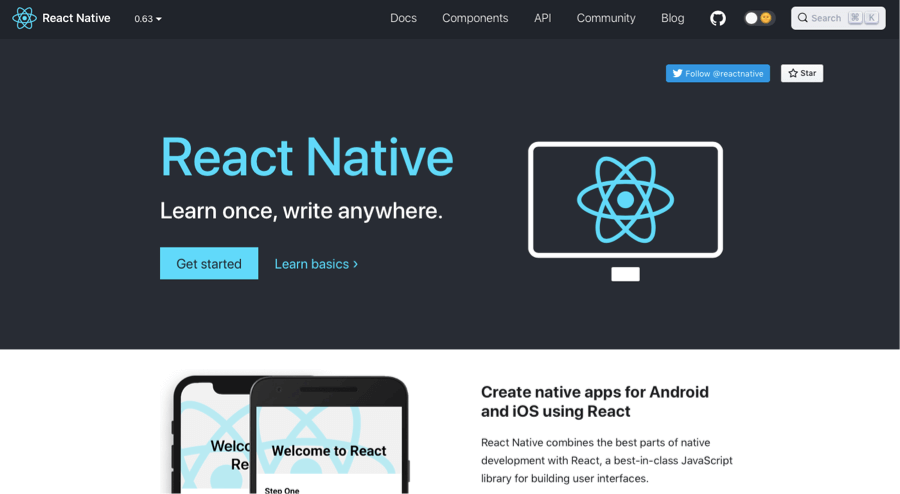App with React Native and GraphQL
Facebook’s React Native and GraphQL were developed as an internal solution for the company’s mobile solutions and later, they were open sourced to the developer community. Ever since then, they have become popular among developers and have become a preferred solution for building services.
Contents
What is React Native?

React Native is an open-source mobile application framework designed by Facebook. It is utilized to develop apps for Windows, Android, iOS, Android TV, macOS, Web, tvOS, and UWP by allowing developers to make use of React’s framework along with the capabilities of the native platform.
The best parts of native development with React are combined by React Native, along with a cutting-edge JavaScript library for developing user interfaces. It can be used in your existing iOS and Android projects or to create an application from scratch.
With React Native, developers can create platform-specific versions of components so that a single codebase can share code throughout different platforms. As it provides a set of platform-agnostic native components, such as image, text, and view, it can directly map to the native UI building blocks of the platform.
What are the advantages of React Native?
- Community-driven – Originally, the React Native framework was developed to respond to the need of the developer community, which is a mobile alternative combining the advantages of mobile application development with the agility and power of the native React environment. This resulted in Facebook creating React Native, which is a framework that supports and continuously pushes the development community. Using such a community-driven environment has its perk like enthusiastic native and JS developers willing to share their knowledge.
- Live reload – React Native builds on the ideas of React and allows users to create powerful mobile apps. It includes the ‘live reload’ feature that enables developers to immediately see the result of the changes that they have made to the code.
- Maximum code reuse – React Native lets you use the same code for deployment on Android and iOS. This results in huge savings in development cost and time.
- Modular & intuitive architecture – The modular & intuitive architecture interface of React Native makes it simple for developers to build upon someone else’s project.
- Strong performance for mobile devices – React Native is well-tuned to mobile devices and makes use of Graphics Processing Unit (GPU).
What is GraphQL?

GraphQL is an open-source manipulation and data query language for APIs. It is a runtime for satisfying queries with existing data. In 2012, Facebook internally developed GraphQL and publicly released it in 2015. The GraphQL project was moved from Facebook on 7th November 2018 to the newly-established GraphQL Foundation that is hosted by Linux Foundation.
GraphQL provides an approach to developing web APIs and it has been contrasted and compared with other web service architectures like REST. Clients are allowed to define the structure of required data and the same structure of the data is returned to the server. This helps in preventing excessive amounts of data from being returned. The richness and flexibility of the query language add complexity that might not be worthwhile for simple APIs.
GraphQL consists of a query language, type system and execution semantics, type introspection, and static validation. Its servers are available for multiple languages like Haskell, Ruby, JavaScript, Java, Python, PHP, C#, C++, and so on.
GraphQL vs. REST | What are the differences?
| GraphQL | REST |
| GraphQL is a query language providing flexibility and efficiency for solving problems that are commonly faced when integrating APIs. | REST is an architectural style that is viewed largely as a traditional standard for designing APIs. |
| Utilizes an architecture that is client-driven | Utilizes an architecture that is server-driven |
| Deployed over HTTP by making use of a single endpoint that offers the full capabilities of the exposed service | Deployed over a range of URLs where each of them unveils a single resource |
| Absence of an automatic caching mechanism | Makes use of automatic caching |
| JSON representation only | Multiple data formats are supported |
| API versioning is not supported | Multiple API versions are supported |
| When it comes to identifying errors, complicates the handling of HTTP status codes | Easily identifies errors by making use of HTTP status codes |
| GraphiQL is the only tool that is utilized predominantly for documentation | For automated documentation, there is a wide range of options including API Blueprint and OpenAPI |
What are the advantages of GraphQL?
- Faster – Compared to other communication APIs, GraphQL is faster because it facilitates users to reduce their request query by selecting only the specific fields that they want to query.
- Microservices – Migrating from a monolithic backend app to a microservice architecture with GraphQL can help you in handling communication between multiple microservices seamlessly. This is because GraphQL merges them into one GraphQL schema.
- No Over-Fetching – GraphQL’s primary advantage is that it fetches only the specific and exact data in a single request, and therefore, there is no over-fetching.
Conclusion
The app development process is simplified with the introduction of GraphQL and React Native. These frameworks are modern and gaining a lot of momentum in mobile and web development.
Please learn more about this topic reading Graphql Backend as a Service and GraphQL providers.
FAQ
What is React Native?
React Native is an open-source mobile application framework designed by Facebook.
What is GraphQL?
GraphQL is an open-source manipulation and data query language for APIs.



